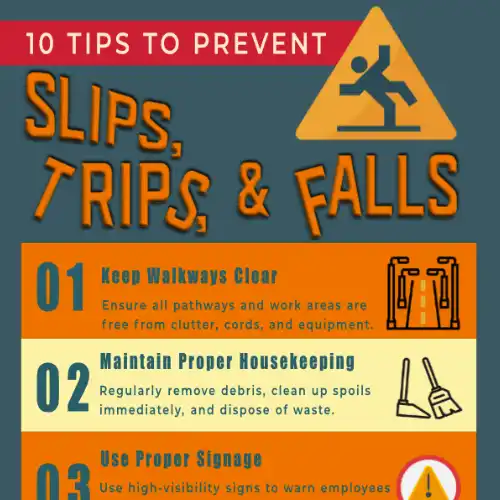PREVENTION: Slips, Trips, and Falls
Slips, trips, and falls are among the leading causes of workplace injuries across industries. These incidents can lead to serious injuries, lost productivity, and costly workers' compensation claims. The good news? Most of these accidents are preventable with the right safety measures.

Infographic: 10 Tips to Prevent Slips, Trips, and Falls
By implementing these preventive measures, companies can significantly reduce workplace injuries caused by slips, trips, and falls. A proactive approach to safety not only protects employees but also improves overall productivity and workplace morale.
Stay safe and stay prepared!
1. Keep Walkways Clear
Ensure all pathways, hallways, and work areas are free from clutter, cords, and equipment. Unnecessary obstructions increase the risk of tripping hazards.
2. Maintain Proper Housekeeping
A clean workplace is a safe workplace. Regularly remove debris, clean up spills immediately, and dispose of waste properly to prevent potential hazards.
3. Use Proper Signage
Use high-visibility signs to warn employees and visitors about wet floors, uneven surfaces, and temporary hazards. This helps create awareness and prevents unexpected accidents.
4. Improve Lighting
Poorly lit work areas can make it difficult to spot hazards. Ensure that workspaces, hallways, stairwells, and outdoor areas are well-lit to improve visibility.

5. Wear Proper Footwear
Employees should wear slip-resistant footwear suitable for the work environment. Shoes with good traction reduce the chances of slipping, especially in wet or oily conditions.
6. Install Handrails and Guardrails
Handrails on stairs and elevated platforms provide support and prevent falls. Guardrails help protect employees from dangerous drop-offs or open edges.
7. Fix Flooring Issues Promptly
Damaged flooring, loose carpeting, and uneven surfaces should be repaired as soon as possible. Temporary solutions, like warning signs and barriers, should be in place until permanent repairs are completed.
8. Encourage Safe Walking Practices
Encourage employees to walk cautiously, avoid rushing, and use designated walkways. Remind them to keep their eyes on their path and avoid distractions like looking at phones while walking.
9. Implement a Slip-Resistant Floor Treatment
Applying anti-slip coatings or mats in high-risk areas, such as entryways and kitchens, can provide extra grip and reduce slipping hazards.
10. Conduct Regular Safety Training
Educate employees on slip, trip, and fall hazards through regular safety training. Training sessions should include best practices, hazard recognition, and proper response in case of an incident.
Need Workplace Safety Training?
At ASI, we provide comprehensive safety training programs tailored to your industry’s needs. Contact us today to schedule a session and keep your workplace injury-free!









